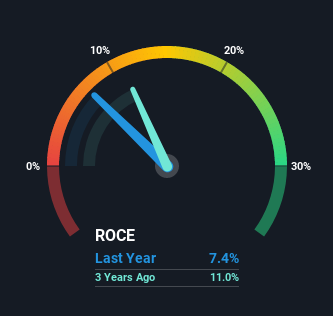- India
- /
- Industrials
- /
- NSEI:GODREJIND
Godrej Industries' (NSE:GODREJIND) Returns On Capital Not Reflecting Well On The Business

Finding a business that has the potential to grow substantially is not easy, but it is possible if we look at a few key financial metrics. Amongst other things, we'll want to see two things; firstly, a growing return on capital employed (ROCE) and secondly, an expansion in the company's amount of capital employed. This shows us that it's a compounding machine, able to continually reinvest its earnings back into the business and generate higher returns. Having said that, from a first glance at Godrej Industries (NSE:GODREJIND) we aren't jumping out of our chairs at how returns are trending, but let's have a deeper look.
Return On Capital Employed (ROCE): What is it?
If you haven't worked with ROCE before, it measures the 'return' (pre-tax profit) a company generates from capital employed in its business. The formula for this calculation on Godrej Industries is:
Return on Capital Employed = Earnings Before Interest and Tax (EBIT) ÷ (Total Assets - Current Liabilities)
0.074 = ₹9.1b ÷ (₹230b - ₹106b) (Based on the trailing twelve months to December 2020).
Thus, Godrej Industries has an ROCE of 7.4%. In absolute terms, that's a low return and it also under-performs the Industrials industry average of 9.4%.
See our latest analysis for Godrej Industries

Historical performance is a great place to start when researching a stock so above you can see the gauge for Godrej Industries' ROCE against it's prior returns. If you'd like to look at how Godrej Industries has performed in the past in other metrics, you can view this free graph of past earnings, revenue and cash flow.
What Does the ROCE Trend For Godrej Industries Tell Us?
On the surface, the trend of ROCE at Godrej Industries doesn't inspire confidence. Over the last five years, returns on capital have decreased to 7.4% from 10% five years ago. And considering revenue has dropped while employing more capital, we'd be cautious. This could mean that the business is losing its competitive advantage or market share, because while more money is being put into ventures, it's actually producing a lower return - "less bang for their buck" per se.
On a related note, Godrej Industries has decreased its current liabilities to 46% of total assets. So we could link some of this to the decrease in ROCE. Effectively this means their suppliers or short-term creditors are funding less of the business, which reduces some elements of risk. Since the business is basically funding more of its operations with it's own money, you could argue this has made the business less efficient at generating ROCE. Keep in mind 46% is still pretty high, so those risks are still somewhat prevalent.
The Bottom Line
We're a bit apprehensive about Godrej Industries because despite more capital being deployed in the business, returns on that capital and sales have both fallen. But investors must be expecting an improvement of sorts because over the last five yearsthe stock has delivered a respectable 55% return. In any case, the current underlying trends don't bode well for long term performance so unless they reverse, we'd start looking elsewhere.
If you'd like to know more about Godrej Industries, we've spotted 2 warning signs, and 1 of them is potentially serious.
While Godrej Industries may not currently earn the highest returns, we've compiled a list of companies that currently earn more than 25% return on equity. Check out this free list here.
When trading Godrej Industries or any other investment, use the platform considered by many to be the Professional's Gateway to the Worlds Market, Interactive Brokers. You get the lowest-cost* trading on stocks, options, futures, forex, bonds and funds worldwide from a single integrated account. Promoted
New: Manage All Your Stock Portfolios in One Place
We've created the ultimate portfolio companion for stock investors, and it's free.
• Connect an unlimited number of Portfolios and see your total in one currency
• Be alerted to new Warning Signs or Risks via email or mobile
• Track the Fair Value of your stocks
This article by Simply Wall St is general in nature. It does not constitute a recommendation to buy or sell any stock, and does not take account of your objectives, or your financial situation. We aim to bring you long-term focused analysis driven by fundamental data. Note that our analysis may not factor in the latest price-sensitive company announcements or qualitative material. Simply Wall St has no position in any stocks mentioned.
*Interactive Brokers Rated Lowest Cost Broker by StockBrokers.com Annual Online Review 2020
Have feedback on this article? Concerned about the content? Get in touch with us directly. Alternatively, email editorial-team (at) simplywallst.com.
About NSEI:GODREJIND
Godrej Industries
Engages in the chemical, consumer goods, real estate, agriculture, and financial services businesses in India and internationally.
Solid track record with imperfect balance sheet.
Similar Companies
Market Insights
Community Narratives


